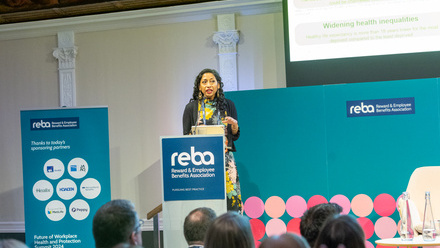The top five employee benefits trends for 2021

1. Wellbeing will be the primary driver for benefits
In recent years, employee wellbeing has been rising up the corporate agenda. But the pandemic has accelerated many businesses’ plans, forcing them to fast-track their approach.
Lockdown has proved that remote working can work. But it brings with it a new set of wellbeing challenges; digital fatigue, blurred lines between home and work, social isolation and a lack of exercise.
And when we consider the economic outlook, many employees are dealing with money worries and fears over job security. However we define it, our wellbeing has worsened in the past 12 months, while supporting it has only become more challenging.
As businesses start to turn their attention to recovery in 2021, providing their employees with the support, tools and initiatives to improve and maintain all aspects of their wellbeing will be key. And it will be heavily reliant on technology to deploy it, and company culture to sustain its lasting impact.
2. Governance for all benefits, not just for pensions
When it comes to governance, it has always been synonymous with pensions. The reasons for this are somewhat historical and somewhat self-evident in that it ensures providers, employers and trustees are held to account for member outcomes.
The question is, why haven’t we done this for other benefits? We believe the answer lies in the fact that benefits were historically seen as a collection of different products serving different needs. Heading into 2021, however, benefits seem to have a new focus and collective purpose in supporting employee wellbeing, be that financial, physical, mental or social.
It makes sense that benefits, or perhaps wellbeing, governance becomes a mainstay of other employee benefits too. By applying the same rigour, having clear goals and measures in place, and taking time to understand if these benefits are supporting employees effectively, it will ultimately lead to better performing schemes and improved outcomes.
3. Flex will evolve…to support wellbeing
For the past 20 years, flexible benefits were the heart of employee benefit programmes. And rightly so – as defined contribution schemes struggled to prove a valuable enough replacement to legacy defined benefit plans, choice was identified as the missing ingredient to re-engage employees. And it worked.
Heading into 2021, however, benefit design and, indeed, purpose has evolved. Choice is no longer the panacea, the silver bullet to cure all ills – it was only ever the means to an undefined end. Now that the pandemic, lessons learned and challenges created by 2020 have come to the fore, it feels like we’ve had our epiphany – yes, choice is great, but the guiding principle of benefits design has become apparent – and it’s wellbeing. This means several things, as far as great flexible benefits go.
First, they cannot be a standalone initiative, driving consumer-like choice regarding technology schemes, pet insurance and the like – they need to be integrated with the entire benefits and wellbeing agenda, with the choice focused on products and services that support wellbeing and emphasise prevention.
Second, flex needs to be supported by other initiatives, such as wellbeing activities, in order to drive participation and connect the dots between health products, such as screening, and employees taking action around their lifestyle and wellbeing choices to ensure they create sustained positive impact.
Ultimately, choice is always a good thing, but now we have clarity on the outcome, it must have purpose.
4. Benefits, via wellbeing, will hit the culture agenda
Wellbeing is shaping the cultural agenda in most workplaces, as senior management are taking note of the fact employees want to work somewhere that recognises and supports their needs and challenges. Just look at the past 12 months for evidence of that.
What does this really mean? Well, in the past, benefits have formed a major part of attraction and retention strategy, as they have been seen as “big ticket”, expensive items that add to one’s reward. That is broadly still the case. The difference now is that with the focus on wellbeing, the lines are blurred between the role of benefits and the role of the wider organisation.
As a result, benefits and wellbeing leaders are being asked by their businesses to help shape the wider cultural agenda, as the mental health impact of work and home pressures (and the perfect storm of the two during Covid and home-schooling) is top of the agenda for CEOs around the country. In response, HR and reward needs to make sure it has a clear framework for defining both the problem and the solution.
5. Pensions are great, but hard work
Pensions are brilliant. There, I said it. Or more accurately, the changes to pensions in recent years have been a brilliant success. Automatic enrolment (AE) has put 10 million new savers into the retirement sphere, with it the government has helped drive down the cost, whilst ensuring the quality of plans and the response (in pension freedoms) to dwindling annuity rates has seen a dramatic shift in member actions.
Not only that, almost any research you seek out suggests that they are still seen as one of, if not THE most valuable benefit in the eyes of employees. Well worth the investment by employers.
The challenge is that with so much change, even when clearly for the better, there ends up being unforeseen, or at least, as-yet-unmanaged, consequences. With AE has come the proliferation of small pots, so much of an issue, that there is a task force to see just what can be done about them.
And so it is with pension freedoms. The choices that it opened up, together with the tax and financial advantages of drawdown (over annuities) was the perfect antidote to 3% annuities. That said, it opened the door for mis-selling scandals and employees looked to take advice on the best option for them.
What does this mean for HR teams in 2021? Put simply, the need to do more. At a time when the business case to increase funding will be hard to justify, charges are already low and investment performance is typically unpredictable, the key is education to help employees navigate the myriad issues and options whether at the start or end of their retirement planning journey. Get communicating!
The author is Matthew Gregson, head of corporate at Howden Employee Benefits & Wellbeing.
This article is provided by Howden Employee Benefits & Wellbeing.
In partnership with Howden Employee Benefits & Wellbeing
Howden provides insurance broking, risk management and claims consulting services, globally. We work with clients of all sizes to provide dedicated employee benefits & wellbeing consultancy.







